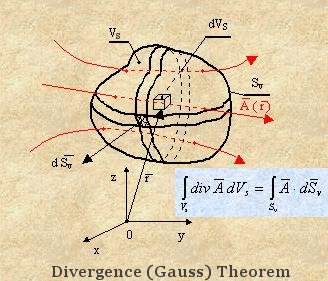 Noether's Theorem and Charge Conservation
Noether's Theorem and Charge Conservation| Home Page | Overview | Site Map | Index | Appendix | Illustration | About | Contact | Update | FAQ |
 Noether's Theorem and Charge Conservation
Noether's Theorem and Charge Conservation |
The Noether's theorem in field theory takes the form of the conservation of current: where the four-current J   is defined as: is defined as: , ,where  is the index for the space-time, is the index for the space-time,  indicates the component of the field, and indicates the component of the field, and    represents a small variation in the represents a small variation in the  th parameter denoted as th parameter denoted as  . From this conserved current, we can also establish a conserved . From this conserved current, we can also establish a conserved
|
Figure 01d Gauss Theorem |
charge by integrating the equation over a volume in the three dimensional space. Applying the Gauss theorem (see Figure 01d), the term with spatial derivative can be converted into a surface integral, which would vanish |
 ,
, = constant. Note that the conservation of charge would not be valid if there is source or sink within the volume.
= constant. Note that the conservation of charge would not be valid if there is source or sink within the volume.  ,
, . These two independent scalar fields can be varied by the internal phase transformation:
. These two independent scalar fields can be varied by the internal phase transformation: |
or, in a more familiar form: |  , , |
 is the parameter corresponding to
is the parameter corresponding to 
 (
( is omitted for single parameter). This U(1) symmetry generates the four-current :
is omitted for single parameter). This U(1) symmetry generates the four-current : . It follows that the conserved charge corresponding to this current is:
. It follows that the conserved charge corresponding to this current is: